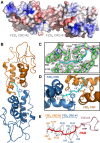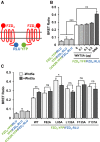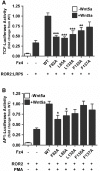Wnt5a promotes Frizzled-4 signalosome assembly by stabilizing cysteine-rich domain dimerization
- PMID: 28546512
- PMCID: PMC5458758
- DOI: 10.1101/gad.298331.117
Wnt5a promotes Frizzled-4 signalosome assembly by stabilizing cysteine-rich domain dimerization
Abstract
Wnt/β-catenin signaling is activated when extracellular Wnt ligands bind Frizzled (FZD) receptors at the cell membrane. Wnts bind FZD cysteine-rich domains (CRDs) with high affinity through a palmitoylated N-terminal "thumb" and a disulfide-stabilized C-terminal "index finger," yet how these binding events trigger receptor activation and intracellular signaling remains unclear. Here we report the crystal structure of the Frizzled-4 (FZD4) CRD in complex with palmitoleic acid, which reveals a CRD tetramer consisting of two cross-braced CRD dimers. Each dimer is stabilized by interactions of one hydrophobic palmitoleic acid tail with two CRD palmitoleoyl-binding grooves oriented end to end, suggesting that the Wnt palmitoleoyl group stimulates CRD-CRD interaction. Using bioluminescence resonance energy transfer (BRET) in live cells, we show that WNT5A stimulates dimerization of membrane-anchored FZD4 CRDs and oligomerization of full-length FZD4, which requires the integrity of CRD palmitoleoyl-binding residues. These results suggest that FZD receptors may form signalosomes in response to Wnt binding through the CRDs and that the Wnt palmitoleoyl group is important in promoting these interactions. These results complement our understanding of lipoprotein receptor-related proteins 5 and 6 (LRP5/6), Dishevelled, and Axin signalosome assembly and provide a more complete model for Wnt signalosome assembly both intracellularly and at the membrane.
Keywords: Frizzled; Frizzled-4; WNT5A; Wnt; cysteine-rich domain; signalosome.
© 2017 DeBruine et al.; Published by Cold Spring Harbor Laboratory Press.
Figures







References
-
- Anastas JN, Moon RT. 2013. WNT signalling pathways as therapeutic targets in cancer. Nat Rev Cancer 13: 11–26. - PubMed
-
- Bilic J, Huang YL, Davidson G, Zimmermann T, Cruciat CM, Bienz M, Niehrs C. 2007. Wnt induces LRP6 signalosomes and promotes dishevelled-dependent LRP6 phosphorylation. Science 316: 1619–1622. - PubMed
Publication types
MeSH terms
Substances
Grants and funding
LinkOut - more resources
Full Text Sources
Other Literature Sources
